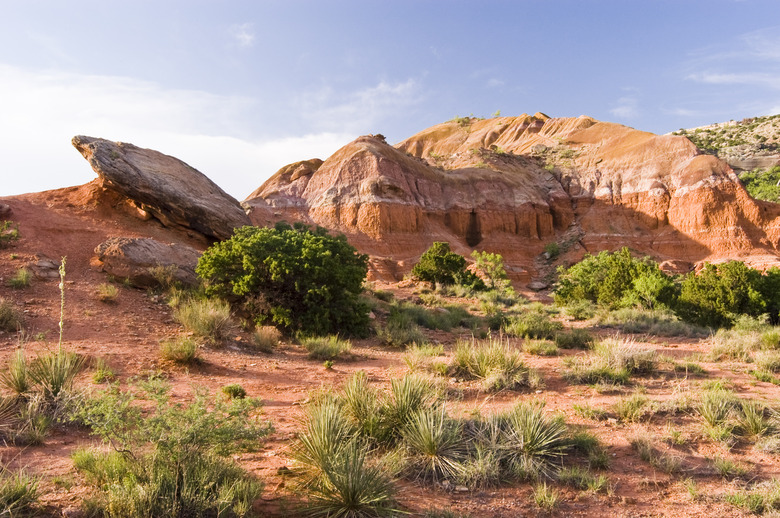How To Identify Texas Rocks
Once overlain by the Tethys Sea, Texas boasts rich limestone deposits along with inactive volcanoes, unique uplifted areas, coal-rich lowlands, coastal sands, mountain ranges and deserts. Igneous, metamorphic and sedimentary rocks can all be found in Texas, along with several fossils and precious and semi-precious crystals and gemstones.
Igneous Rocks
Igneous Rocks
Igneous rocks, formed from the cooling of magma from deep within the earth, form extrusive and intrusive varieties. Extrusive, or volcanic, igneous rocks form from rapidly cooling magma that reaches the Earth's surface. When magma cools quickly, the crystalline structures that form are tiny and often indistinguishable from one another.
In west Texas, lava flowed to the surface and hardened during the Tertiary period, forming the mountains of the Big Bend area. Intrusive igneous rocks form granite when magma cools more slowly beneath the earth's crust. Granite contains different colors because the molten rock cools slowly enough that you can see the minerals of feldspar, mica, hornblende and quartz that form within it.
There are granite deposits in west Texas, the Balcones Fault Zone and – perhaps the best known example – the Llano Uplift. At the last example, you can climb Enchanted Rock, a huge granite uplift that formed underground and became visible when the covering layers of the earth's crust eroded away.
Sedimentary Rocks
Sedimentary Rocks
Rocks of all shapes and sizes, soils, and plant and animal materials are transported across the landscape by wind or water and deposited onto the earth. Over time and under pressure, these can form sedimentary rocks, such as sandstone, formed from the deposition of sands, siltstones, formed from the deposition of silt, and shale, formed from the deposition of mud and clay.
Another pervasive sedimentary rock in Texas is limestone. Much of the limestone in Texas is filled with fossils of animals that thrived when the area was under water. As those animals died, their calcium carbonate shells sunk to the bottom of the sea and were later cemented together with the help of dissolved rock materials precipitating out of solution. The holes commonly visible in limestone are formed from the dissolution of this calcium carbonate, making way for the development of caves and huge underground aquifers.
Metamorphic Rocks
Metamorphic Rocks
Under the right combination of pressure, time, fluids and heat, rock types can change, or metamorphose, forming metamorphic rocks. Granite can metamorphose into gneiss, limestone can harden into marble, shale can be changed into slate. Static metamorphosis occurs when rocks buried deep beneath the Earth's surface have enough younger rocks deposited on top of them to form great pressures and expose them to the hotter temperatures that occur deeper underground.
Contact metamorphosis occurs when the heat, liquids, gasses and pressure from hot magma moving over rocks underground cause them to change. Dynamic metamorphosis is one of the processes that forms mountain ranges. During dynamic metamorphosis, heat and pressure under the Earth's crust cause flat layers of rock to be pushed upwards into arches, which can then break and fracture or slide over one another.
Identifying Texas Rocks and Minerals
Identifying Texas Rocks and Minerals
Rock identification begins with the categorization of certain characteristics of the rock or mineral. The first characteristics are luster, or how shiny a mineral is, and color. Next you will determine the hardness by testing whether a metallic mineral will leave a mark on paper, or – if not – whether it can be scratched by a pocket knife.
The tests for hardness for nonmetallic minerals are whether it can be scratched by a fingernail, a copper penny, a pocket knife or a piece of quartz. Once you have determined the luster, color and hardness of a mineral, other characteristics can be used to narrow down the identification, such as what a mineral tastes or smells like, or if it will readily burn and what color flame is produced.
Texas Gemstones
Texas Gemstones
The Llano Uplift produces the state gemstone of Texas, blue topaz, which is incredibly resistant to erosion and can occur in a variety of colors from sky blue to white. The mountainous areas of west Texas produce uniquely banded agates, petrified wood, fossilized coral and dinosaur bones, and rare tangerines and amethyst.
The Panhandle region produces a few agates and some petrified wood, but is best known for a unique variety of flint called Alibates, which can be pink or blue and was used by Native Americans to make tools. Petrified fern wood formed in the warm, wet regions of east Texas has become the Texas state rock. It is most prized when found with a light, creamy outside and black, shiny inside.
Cite This Article
MLA
Reid, Ari. "How To Identify Texas Rocks" sciencing.com, https://www.sciencing.com/identify-texas-rocks-4479847/. 2 November 2021.
APA
Reid, Ari. (2021, November 2). How To Identify Texas Rocks. sciencing.com. Retrieved from https://www.sciencing.com/identify-texas-rocks-4479847/
Chicago
Reid, Ari. How To Identify Texas Rocks last modified August 30, 2022. https://www.sciencing.com/identify-texas-rocks-4479847/
